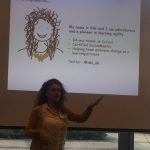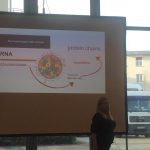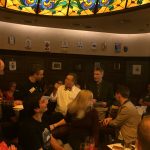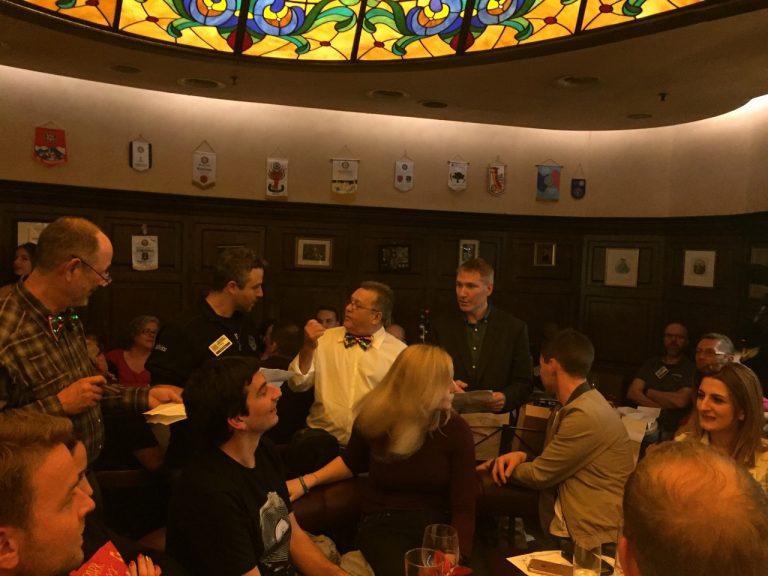My day got off to a bright start with day 2 of Lean Coffee, it was a full room in spite of the fun social events of the previous evening! I had no more sessions to do myself, so I could relax and focus on learning.
Diana Larsen Lifts Off!
I have six pages of sketch notes from Diana Larsen‘s keynote, so deciding what highlight to include here is pretty tough. One takeaway is to set conditions for team learning. Keep it alive! Do it for real. Start and stay clear and obvious. Focus on flow. I really wish my own team would do liftoff meetings. There’s an experiment for me to try to get going!
More new voices

Once again the New Voices track attracted me, in spite of several other compelling track sessions. I admit to some bias because I helped a couple of these presenters by giving them feedback on their proposals and slide decks. But they’d have been awesome without my help.
The two speakers I saw this morning are successful presenters now because of their own motivation to seek help and hard work to prepare great sessions. But they would not have had the opportunity without the Agile Testing Days organizers. Viki volunteered last year in order to participate in the conference. She took advantage of the opportunity, participated in every event and session she could, made connections and contributed her own experiences. Melissa was part of the awesome Brazil team that won the Software Testing World Cup in 2014. She has also made connections, asked for help, and contributed her own experiences to the community. José Diaz and his amazing AgileTD team are committed to fostering diversity and inclusion, and bringing in new people to contribute to our community.
Visualizing stories
Viki Manevska (she has a 2nd twitter id, not sure which is the best to use) is trying some real innovations in her visualizations of user stories. She noted that visualizations help our brain, stimulate discussions, identify possible bottlenecks. We’ve all heard some frustrated colleague say “Do I have to draw you a picture?” when we don’t understand something. As Viki noted, if you could draw me a picture, why didn’t you start out with one?
Unfortunately the New Voices room was one plagued with a troublesome beamer. Projection quit just when she was explaining her exercise. Viki kept her cool like an old pro. Our Oregami attempts with written word instructions versus visual instructions left no question about the value of visuals!
Testing human code
Testers add value to any product, but helping to identify and prevent diseases is a really special place to contribute. Melissa Pontes

explained how her team finds bugs in human DNA. It’s especially important to find bugs early. And as with any software, fixing one problem can lead to even more defects. This was a fascinating talk, I can’t fit it all in here. One highlight was learning that Alan Turing wrote extensively on biology and how computer engineering imitates life. And I learned that we can program cells, for example, they can program bacteria to eat pollution. This was so inspiring – and we can help! Learn more about it at cesar.org.br.
I was tickled when Melissa was talking about risks and said “I’m afraid of flying because I know there’s software there.” Software is everywhere!
Telling our stories
I didn’t think Alex Schladebeck and Huib Schoots could top their terrific musical 2015 keynote, but never underestimate these two. The importance of stories, and especially what makes for a valuable story, is one of my biggest takeaways. I learned from them that vulnerability is essential to leadership – not a weakness. A good story has exposition, rising action, a climax, falling action and a denoument – something to think about when telling our own stories. Stories are neurological walk-thrus for our brain, and help teach culture. Huib and Alex explained the science behind how we make whatever we hear into a story, and our brain fills in any gaps – so don’t leave gaps! Stories need conflict to engage us. In the context of testing, a story should tell what – the status of the product; how – how you tested it; and why – the value of the testing. Give up your detailed test report docs, and tell your testing story with the aid of a mind map or other tool.
I was so moved by Alex’s powerful story of her violin and her dad. Let’s take away the computers and tell our stories!
Guess who!
I’ve enjoyed and learned a lot from Nathalie Rooseboom de Vries van Delft at past conferences – she’s not called FunTESTic for nothing – so I was keen to participate in her workshop on using games such as Clue (aka Cluedo) and Guess Who? to understand our product. Nathalie explained how these games use deductive reasoning and help us get into a questioning mindset about design. They can help us focus. This was a hands-on workshop so I don’t have a lot of notes. We started with a round of “Who Am I” to get our creative juices flowing.

Nathalie played a couple short games of Guess Who? so we understood it. Then we made our own Guess Who? game around something in our own product. I thought this would take forever – I had to draw 12 little icons representing user actions on both sides of my playing device made from heavy paper. And I had to cut down sticky notes so that each picture can be covered up. But it turned out to go pretty fast. I did mine around a feature in our product that allows people to add comments to online user stories. It’s so complicated and the team always forgets how many permutations there are in using it. I can see a lot of value in playing Guess Who? with this feature. I’m sure we would think of more things it does – or should do!
With Clue, Nathalie recommends using the actual game set. The ‘rooms’ can be parts of the system or process, the weapons represent actions, the potential perps are the persons using the system.
Play is fun and an important way to learn. What a great idea to play games to help us think laterally, get out of group think, overcome our innate biases and discover new information about our product!
Speaking of fun…
After three days of conference joy, we were happy but tired and a small group of us went out to enjoy dinner. We got back in time for the

Cabaret, hosted by the amazing Daniel Maslyn as Mephisto something something. It is so fun to see all the talents that conference participants have, besides being amazing at delivering great products! Though the pub was crowded and overly warm, everyone got engaged in singing and in enjoying music and fun. I personally get a bit uncomfortable with a couple of the things like “Battle of the Sexes” though everything is done respectfully and in fun. And a couple things dragged on a bit long. But generally my sides ached from laughing. It was all so creative! My husband Bob Downing got in on the fun as one of the Four Yorkshiremen, joined by Amitai Schleier, Matt Heusser, and Janet’s husband Jack Gregory. I have a feeling that it was a bit lost on this crowd, but trust me, they were hilarious!
Yay, what a great day. I’ll post more about the conference soon! I highly recommend reading others’ Agile TD experiences, you can find a list on Stephan Kämper’s blog post.


